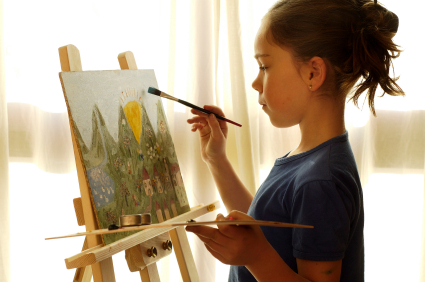
While teaching children the alphabet or how to count may be fairly straightforward, helping children be creative is often not as clear-cut. Should you encourage them to do more art, or take them to museums` Contrary to what you might think, fostering creativity in children often involves some unconventional tactics. This article offers suggestions for helping your child be creative.
Instructions

Provide "Open-Ended" Activities
Step - 1 :When we think of doing activities with children, we often think of a predesigned craft or art activity. We make a model and we say, "Make this______." Or we supply children with coloring books and say, "Color this picture." However, giving children activities with only one way to complete them can stifle creativity. By contrast, providing children with open-ended material, or materials to make something with no preconceived end-result will help them use their own creativity. Good open-ended materials include play dough or plasticine, paint, crayons, markers, and various colors and sizes of paper. Step - 2 : Give them the materials and let them decide what to do with them. You might ask, "What should we make with these`" Resist the urge to draw or make something first, because children might feel they should do the same as you. As adults, our skills are much more refined than children's, leading them to possibly feel inadequate in their own burgeoning abilities when they discover they cannot quite model what we can do. Step - 3 : Encourage children by commenting on what they are doing rather than making evaluative statements like "good job." You might say, "Look at the colors you are using!" or "Look how much fun you are having!" This non-judgmental stance will help them feel good about what they are doing, rather than doing and making things because this behavior pleases you.
Let Children Decide
Step - 1: Children who are allowed to make decisions become more adept at problem solving. Opportunities to make decisions also allow them to be creative in the way they approach problems. This, of course, is for children who are developmentally capable of offering suggestions, but can begin as early as 2 years of age if the child has the verbal skills. Step - 2 : When you are confronted with a problem concerning your child, ask, "What do you think we should do about this`" Step - 3 : Listen to your child and give explanations for suggestions that will not work. However, if your child comes up with an idea that is reasonably acceptable, let him make the choice. Giving a child some amount of control over his world will also help him gain confidence in his abilities. 
Limit Electronic Activities
Step - 1 : Remember that television, video games and computer time are all generally passive activities. They don't allow children to be an active participant, thereby limiting the use of their cognitive skills and creativity. Step - 2 : Decide on an acceptable amount of time for your child to watch television or play on the computer. Discuss with her the times of day and the amount of time she will be able to watch. For instance, you might say, "We can watch two shows after school each day and then the television will be turned off." Step -3 : Watch and play the games with your children. Ask them questions about what they see or what they think will happen next. This will allow children to think about what they see, rather than just being passive observers.
Allow Unstructured Playtime
Step -1 : In an effort to cram as much learning time in as possible, parents often over-structure their children's schedules. But allowing children time for unstructured play lets them be creative. It also allows children time to make mistakes, learn cause and effect, and do things that interest them. Step -2 : Don't worry if your child complains that he is bored. Boredom can be the catalyst for many creative activities. Support your child by asking him what he would like to do. If necessary, offer suggestions or open-ended materials, and say, "What should we do with these`" After a time, even the most ho-hum feeling child will find something to do, and his creativity will likely grow because of it. Step -3 : Provide plenty of down time. This is especially important for children who spend half their day at school. The school day is very structured, so allowing children time to just "hang out" can recharge their creativity.
